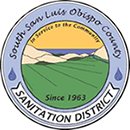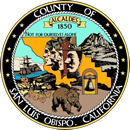Description
Biosolids is a term used by the water treatment industry that refers to treated sludge. Sludge, or “biosolids,” is the byproduct of the treatment of domestic and commercial wastewater or sewage in a wastewater treatment plant. During waste water treatment, bacteria and other microorganisms break down components in wastewater into simpler and more stable forms of organic matter. Non-organic matter also settles into sludge. Biosolids in their liquid form look like muddy water and contain 1-10% solids. Biosolids may be dewatered in a second step of the treatment process, which turns it into a “cake” with the texture of a wet sponge. In this stage it contains 11-40% solids.
According to US EPA, biosolids that meet treatment and pollutant content criteria “can be safely recycled and applied as fertilizer to sustainably improve and maintain productive soils and stimulate plant growth.” The US EPA’s promulgated regulation is 40 CFR Part 503.
Plant Process
At the South San Luis Obispo County Sanitation District the solids are collected at the Primary Clarifier and are either pumped to the Gravity Sludge Thickener, or directly to the Primary Digester. In the Primary Digester, the solids are heated to approximetly 96 degrees and mixed using the pumped vortex method. Detention time in the Primary Digester is approximetly 26 days.
The solids are then transferred to the Secondary Digester which is unheated and unmixed. This allows the sludge to cool and stratify. The supernatant is recycled through the plant for further treatment and the digested solids are drawn off for further processing.
Sludge drying takes place in one of two ways depending on the weather. During the winter months the District uses the centrifuge for the purpose of dewatering the sludge. The material is then stored in the sludge lagoon. Once the weather warms up, operations Staff begins the use of the drying beds with supplemental processing by the centrifuge. Polymer addition is required for proper operation of the centrifuge, however Staff has made several modifications to the feed system allowing for a dryer cake then usually obtained from similar machines (approx. 25%). The solids generated by the centrifuge and drying beds are then stockpiled onsite until transportation to a composting facility is scheduled.
Over the years, the South San Luis Obispo County Sanitation District has maintained an excellent record with the local Regional Board with respect to biosolids. In light of recent and pending regulations, for the last few years the South San Luis Obispo County Sanitation District has processed all biosolids through commercial composting facilities.


